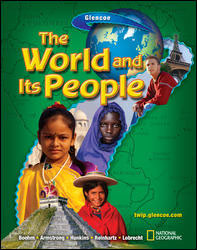
The World and Its PeopleChapter 1: Looking at the EarthChapter OverviewsGeography is the study of the earth and its people. Maps and globes are some of the tools used to study the physical and human characteristics of our planet. LANDSAT photos and Geographic Information Systems (GIS) help geographers provide information used by government and business leaders as they plan and make decisions. Our planet, Earth, is part of a solar system made up of a sun, nine planets, and thousands of smaller bodies. Life on Earth could not exist without the heat and light provided by the sun or the atmosphere of gases that surrounds the planet. The earth's rotation creates a twenty-four hour day and night, while its orbit around the sun and 23½ degree tilt produce the seasons. Inside the earth are layers of varying thickness and composition: the inner core, outer core, mantle, and crust. Scientists theorize that volcanoes, earthquakes, and continental drift are caused by the movement of tectonic plates that float on top of the liquid rock in the mantle. The forces of weathering and erosion also continually change the earth's surface. People have adapted in order to live on various landforms. Mountains, plateaus, valleys, and other landforms are found on land and under the oceans. About 70 percent of the earth's surface is water. |  |















